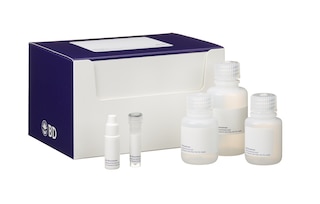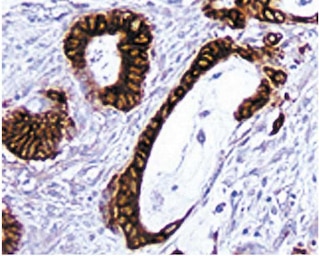Old Browser
This page has been recently translated and is available in French now.
Looks like you're visiting us from {countryName}.
Would you like to stay on the current country site or be switched to your country?




Immunohistochemical staining of T lymphocytes. The frozen section of normal rat spleen was reacted with Purified Mouse Anti-Rat CD3 (Cat. No. 550295). T lymphocytes in the periarteriolar sheath, are identified by the brown labeling of their cell surface membrane.


BD Pharmingen™ Purified Mouse Anti-Rat CD3

Regulatory Status Legend
Any use of products other than the permitted use without the express written authorization of Becton, Dickinson and Company is strictly prohibited.
Preparation And Storage
Recommended Assay Procedures
Immunohistochemistry: Purified Mouse Anti-Rat CD3 (Cat. No. 550295) is recommended to test for immunohistochemical staining of acetone-fixed frozen sections and paraffin sections. Tissue tested was rat spleen. The antibody stains T lymphocytes. The isotype control recommended for use with this antibody is Purified Mouse IgG3, κ Isotype Control (Cat. No. 550341). For optimal indirect immunohistochemical staining, the G4.18 antibody should be titrated (1:10 to 1:50 dilution) and visualized via a three-step staining procedure in combination with Purified Mouse IgG3, κ Isotype Control (Cat. No. 553401) as the secondary antibody and Streptavidin HRP (Cat. No. 550946) together with the DAB Substrate Kit (Cat. No. 550880).
Product Notices
- Since applications vary, each investigator should titrate the reagent to obtain optimal results.
- An isotype control should be used at the same concentration as the antibody of interest.
- Caution: Sodium azide yields highly toxic hydrazoic acid under acidic conditions. Dilute azide compounds in running water before discarding to avoid accumulation of potentially explosive deposits in plumbing.
- Source of all serum proteins is from USDA inspected abattoirs located in the United States.
- This antibody has been developed for the immunohistochemistry application. However, a routine immunohistochemistry test is not performed on every lot. Researchers are encouraged to titrate the reagent for optimal performance.
- Sodium azide is a reversible inhibitor of oxidative metabolism; therefore, antibody preparations containing this preservative agent must not be used in cell cultures nor injected into animals. Sodium azide may be removed by washing stained cells or plate-bound antibody or dialyzing soluble antibody in sodium azide-free buffer. Since endotoxin may also affect the results of functional studies, we recommend the NA/LE (No Azide/Low Endotoxin) antibody format, if available, for in vitro and in vivo use.
- Please refer to www.bdbiosciences.com/us/s/resources for technical protocols.
- Please refer to http://regdocs.bd.com to access safety data sheets (SDS).
Companion Products





The G4.18 monoclonal antibody specifically recognizes the T-cell receptor-associated CD3 cell-surface antigen found on thymocytes, peripheral T lymphocytes, and dendritic epidermal T cells. It has been reported that CD3 expression is down-regulated within 24 hours in concanavalin A-stimulated rat T cells, and soluble mAb inhibits the allogeneic mixed-lymphocyte proliferative response and cell-mediated cytotoxicity to allogeneic target cells. In vivo treatment with G4.18 mAb prevents cardiac and skin allograft rejection, resulting in donor-specific tolerance. Pre-incubation of splenocytes with the alternate anti-rat CD3 monoclonal antibody, 1F4, blocks staining with mAb G4.18.
Development References (3)
-
Naper C, Vaage JT, Lambracht D, et al. Alloreactive natural killer cells in the rat: complex genetics of major histocompatibility complex control. Eur J Immunol. 1995; 25(5):1249-1256. (Clone-specific: Cytotoxicity). View Reference
-
Nelson DJ, McMenamin C, McWilliam AS, Brenan M, Holt PG. Development of the airway intraepithelial dendritic cell network in the rat from class II major histocompatibility (Ia)-negative precursors: differential regulation of Ia expression at different levels of the respiratory tract. J Exp Med. 1994; 179(1):203-212. (Clone-specific: Immunohistochemistry). View Reference
-
Nicolls MR, Aversa GG, Pearce NW, et al. Induction of long-term specific tolerance to allografts in rats by therapy with an anti-CD3-like monoclonal antibody.. Transplantation. 1993; 55(3):459-68. (Immunogen: Cytotoxicity, Flow cytometry, Immunohistochemistry, Immunoprecipitation, Inhibition, Stimulation). View Reference
Please refer to Support Documents for Quality Certificates
Global - Refer to manufacturer's instructions for use and related User Manuals and Technical data sheets before using this products as described
Comparisons, where applicable, are made against older BD Technology, manual methods or are general performance claims. Comparisons are not made against non-BD technologies, unless otherwise noted.
For Research Use Only. Not for use in diagnostic or therapeutic procedures.
Report a Site Issue
This form is intended to help us improve our website experience. For other support, please visit our Contact Us page.